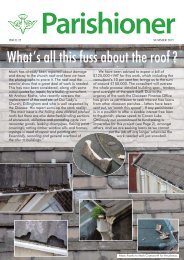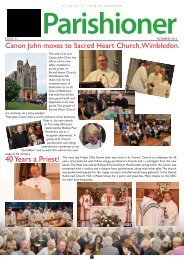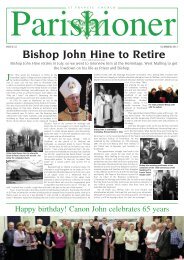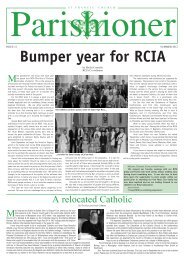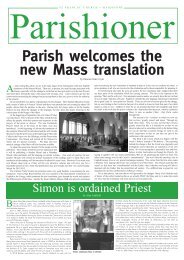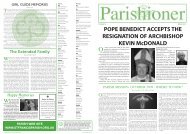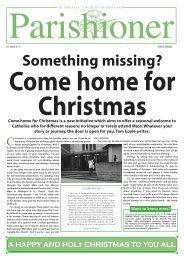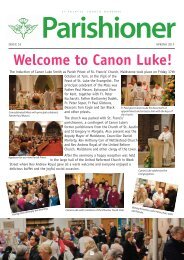The Parishioner - Edition 26|Spring 2016
The Parishioner is the twice yearly publication of St. Francis' Catholic Parish, Maidstone.
The Parishioner is the twice yearly publication of St. Francis' Catholic Parish, Maidstone.
Create successful ePaper yourself
Turn your PDF publications into a flip-book with our unique Google optimized e-Paper software.
St.Edmund Gennings<br />
Text and Picture by Charlotte Cassidy<br />
During the reign of Queen Elizabeth 1, (1558 to 1603), when the Anglican faith<br />
became the nation’s state religion by law and Catholics were being persecuted,<br />
St. Edmund Gennings was born in Lichfield, Staffordshire, England, in 1567.<br />
His parents were innkeepers, loyal to the Queen, and raised Edmund and his<br />
younger brother, John, in the Anglican faith. As a child, Edmund was a serious, studious<br />
boy and excelled in his class at Lichfield Grammar School.<br />
At the age of sixteen when his education was complete, Edmund went to work as<br />
a page in London in the house of renowned drapers, Mr. and Mrs. Sherwood. <strong>The</strong><br />
Sherwoods were devout Catholics, their four sons were Catholic priests. <strong>The</strong> couple<br />
had been imprisoned numerous times for their faith and could only attend<br />
Mass in secret. <strong>The</strong> Sherwoods treated Edmund more like another son<br />
than an employee. Inspired by Mr. Sherwood’s love and knowledge<br />
of the Gospel, Edmund soon became drawn to the catholic faith<br />
and decided to convert to Catholicism. He made his confession<br />
and was received into the Catholic Church, at the age of<br />
sixteen and attended his first Mass in secret in the<br />
Sherwood’s house.<br />
At that time, the persecution of Catholics was<br />
relentless. <strong>The</strong>y were forbidden to attend Mass or even<br />
pray the Rosary. Catholic laity were often imprisoned for<br />
practising their faith and if Catholic priests were found<br />
secretly celebrating Mass in a house, they were<br />
immediately arrested, brought to a brief, sham trial and<br />
sentenced to a traitor’s death at Tyburn.<br />
While attending his first Mass, Edmund felt a deep love<br />
for Jesus and a calling to the priesthood. It was illegal for any<br />
young man to study for the Catholic priesthood in England so<br />
Edmund left the Sherwood’s employment to study abroad at the<br />
English Biblical college in Rheims, France. At the college, Edmund<br />
befriended fellow Englishman and seminarian, Polydore Plasden. Both young<br />
men hoped to return to England after ordination.<br />
Despite being diagnosed with tuberculosis shortly after his arrival in France,<br />
Edmund managed to complete his studies. Because of his ill-heath a special<br />
dispensation was arranged so that he could be ordained earlier that usual and in<br />
1590, at the age of twenty three, Edmund was ordained a Catholic priest.<br />
A month later, Father Edmund and Fr. Polydore set sail on their return voyage to<br />
England, arriving at Whitby, Yorkshire, late at night. Willing to die for Christ the two<br />
priests then parted company. Fr. Edmund returned to London where he stayed at the<br />
house of Swithun Wells and his family at Gray’s Inn Lane.<br />
Swithun was a kind Catholic layman who had opened his home as a refuge for<br />
the persecuted Catholic priests. After a few days Fr. Edmund left the generous<br />
hospitality of the Wells family and for several months travelled throughout England in<br />
his priestly ministry. He celebrated Mass in secret, heard confessions, anointed the sick<br />
and gave spiritual guidance to the persecuted Catholics.<br />
In November of 1591, Fr. Edmund decided to return again to the home of<br />
Swithun Wells in London. By chance along the road he met his good friend Fr.<br />
Polydore Plasden who was also on his way to Swithun’s home and the two priests<br />
continued their journey together, arriving at their destination at night.<br />
Fr. Edmund rose early the next morning to celebrate Mass in secret with Fr.<br />
Polydore in a room in Swithun’s house. Swithun had been called away the previous<br />
night on a mission of mercy. His wife and daughter, however, had invited several local<br />
Catholics to the Mass. Shortly after Mass had commenced there came a loud thud at<br />
the front door. One of Swithun’s servants went to investigate and realized with alarm<br />
that the Queen’s chief torturer, Richard Topcliffe, had entered the house with soldiers<br />
to arrest Fr. Edmund and Fr. Polydore.<br />
Fr. Polydore confronted Topcliffe and asked that the mass be allowed to conclude,<br />
after which everyone would surrender. Topcliffe agreed to his request. When the Mass<br />
had ended, Fr. Edmund carefully took the Holy Eucharist and the chalice containing the<br />
Blood of Christ and hid them in a cabinet in the house so that they would not be<br />
desecrated by Topcliffe and his soldiers.<br />
4<br />
8<br />
Fr. Edmund tole the faithful present to remain calm and above all loyal to<br />
Christ, then everyone surrendered peacefully to the priest hunters. <strong>The</strong> two priests were<br />
immediately arrested. Fr. Edmund, still in his vestments, was made to wear a fool’s coat<br />
(a long coat with gaudy, multi-coloured plumes) and, together with Fr. Polydore, he was<br />
escorted by soldiers through the streets to Gatehouse Prison.<br />
On arrival at the prison the two priests were put in separate cells. In the<br />
solitude of his cell, Fr.Edmund prayed and told Jesus he loved Him and was prepared<br />
to lay down his life for Him. Later that evening, Fr. Edmund was moved to the prison<br />
dungeon where Topcliffe awaited him. When Fr. Edmund refused to renounce his<br />
faith, he was taken to a torture chamber where he was mocked and<br />
subjected to agonizing torture for hours on the rack.<br />
Six days later, on December 4th 1591, Fr. Edmund and Fr.<br />
Polydore were brought to a sham trial at Westminster, found<br />
guilty of treason and sentenced to death. Swithun Wells,<br />
having been arrested on his return home to Gray’s Inn<br />
Lane, was also sentenced to death.<br />
<strong>The</strong> two priests were offered their freedom if they<br />
rejected the Papacy and their Catholic faith and<br />
conformed to the Anglican religion. Both priests bluntly<br />
refused. Fr. Edmund then denounced Anglicanism and<br />
the Queen as head of the Church on spiritual matters<br />
and declared his undying love for Christ and the<br />
Catholic Church.<br />
Enraged by this declaration, Topcliffe ordered both<br />
priests to be taken to a dungeon in Newgate prison where<br />
they were tortured. Fr. Edmund was then dragged from the<br />
dungeon and thrown in a pit within the prison known as the<br />
‘Dark Hole’. In this narrow, confined, terrifying space Fr. Edmund<br />
could see nothing at all. He passed the days saying the Rosary,<br />
meditating on Christ’s passion and uniting his sufferings to Christ on the<br />
Cross.<br />
On December 10th 1591, Fr. Edmund was at last taken from the ‘Dark Hole’ and<br />
reunited with Fr.Polydore. Both priests were then brought outside to the prison<br />
courtyard, tied to a hurdle along with Swithun Wells and dragged through the streets<br />
of London. Fr. Edmund thought he would die with Fr. Polydore Plasden at Tyburn.<br />
Instead, the group of soldiers escorting the three men abruptly changed direction<br />
at Holborn, taking both Fr. Edmund and Swithun to Gray’s in Lane. A gallows had been<br />
especially erected outside Swithun’s home where Mass had been celebrated only two<br />
weeks earlier. Fr. Edmund was to die with Swithun Wells. As a noose was roughly<br />
placed around Fr. Edmunds neck, his thoughts and prayers remained with Fr. Polydore<br />
who continued on his journey to be hanged drawn and quartered on the infamous<br />
gallows at Tyburn.<br />
Before the gathered, jeering crowd, Topcliffe demanded that Fr. Edmund confess to<br />
treason. Fr. Edmund calmly responded, “If to return to England as a Catholic priest and<br />
to celebrate Mass is considered treason, then, yes, I am guilty of treason with the<br />
greatest joy!”<br />
Furious at his unrepentant reply, Topcliffe instantly devised a particularly cruel<br />
death for Fr.Edmund. Topcliffe ordered that Fr. Edmund be hanged and cut down<br />
almost immediately. Unsteady and barely stunned from the hanging, Fr. Edmund was<br />
then pushed to the ground. He was fully conscious as the executioner began his<br />
gruesome task with a knife. Fr. Edmund could hear Swithun’s prayers for him as he<br />
felt his chest being split open. <strong>The</strong> executioner then ripped Fr. Edmund’s heart from<br />
his chest and held it up before Fr. Edmund’s eyes. In excruciating pain, Fr. Edmund<br />
managed to say these last words, “St. Gregory, pray for me!”<br />
Fr.Edmund was only twenty four. <strong>The</strong>re were many conversions among those who<br />
had witnessed his barbarous death, including the conversion of his younger brother,<br />
John. St.Edmund Gennings was beatified in 1929 by Pope Pius XI and canonized in<br />
1970 by Pope Paul VI. His feast day is 10th of December.





